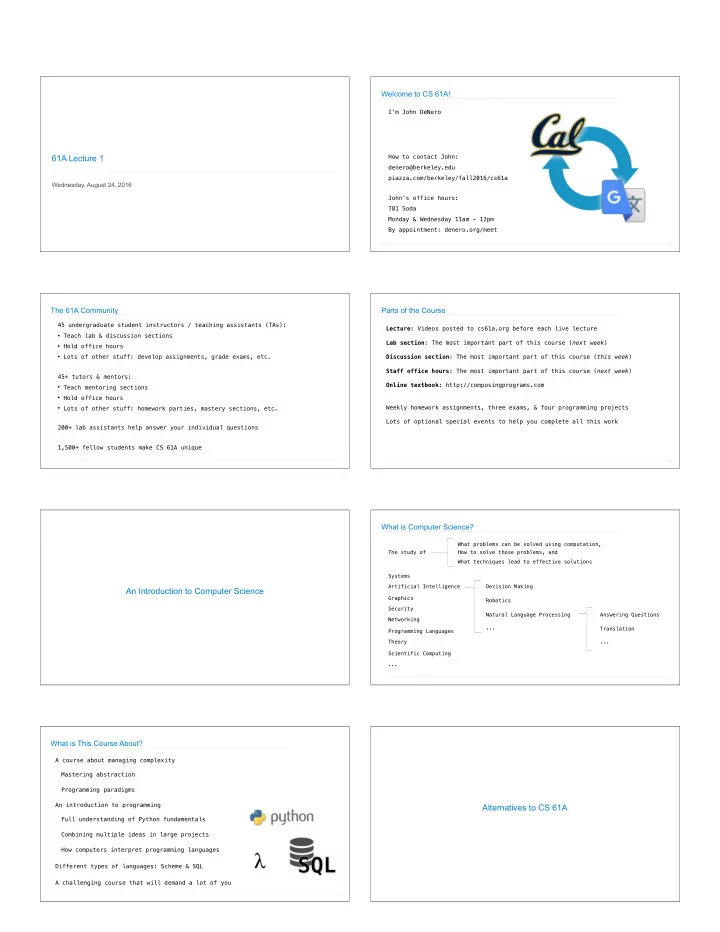

Welcome to CS 61A! I'm John DeNero 61A Lecture 1 How to contact John: denero@berkeley.edu piazza.com/berkeley/fall2016/cs61a Wednesday, August 24, 2016 John's office hours: 781 Soda Monday & Wednesday 11am - 12pm By appointment: denero.org/meet 2 The 61A Community Parts of the Course 45 undergraduate student instructors / teaching assistants (TAs): Lecture : Videos posted to cs61a.org before each live lecture • Teach lab & discussion sections Lab section : The most important part of this course ( next week ) • Hold office hours • Lots of other stuff: develop assignments, grade exams, etc. Discussion section : The most important part of this course ( this week ) Staff office hours : The most important part of this course ( next week ) 45+ tutors & mentors: Online textbook : http://composingprograms.com • Teach mentoring sections • Hold office hours • Lots of other stuff: homework parties, mastery sections, etc. Weekly homework assignments, three exams, & four programming projects Lots of optional special events to help you complete all this work 200+ lab assistants help answer your individual questions 1,500+ fellow students make CS 61A unique 3 4 What is Computer Science? What problems can be solved using computation, The study of How to solve those problems, and What techniques lead to effective solutions Systems Artificial Intelligence Decision Making An Introduction to Computer Science Graphics Robotics Security Natural Language Processing Answering Questions Networking ... Translation Programming Languages Theory ... Scientific Computing ... 6 What is This Course About? A course about managing complexity Mastering abstraction Programming paradigms An introduction to programming Alternatives to CS 61A Full understanding of Python fundamentals Combining multiple ideas in large projects How computers interpret programming languages Different types of languages: Scheme & SQL A challenging course that will demand a lot of you 7
CS 10: The Beauty and Joy of Computing Data Science 8: Foundations of Data Science Designed for students without prior experience Fundamentals of computing, statistical inference, & machine learning applied to real-world data sets A programming environment created by Berkeley, now used in courses around the world and online Great programming practice for CS 61A An introduction to fundamentals (& Python) that sets students up for success in CS 61A Cross-listed as CS C8, Stat C8, & Info C8 Taught in Fall 2016 by Dan Garcia Taught in Fall 2016 by Ani Adhikari More info: cs10.org More info: data8.org & databears.berkeley.edu 9 10 Course Policies Learning Community Course Policies Course Staff Details... http://cs61a.org/articles/about.html 12 Collaboration Asking questions is highly encouraged • Discuss everything with each other; learn from your fellow students! • Homework can be completed with a partner • Projects should be completed with a partner • Choose a partner from your discussion section Expressions The limits of collaboration • One simple rule: Don’t share your code, except with your partner • Copying project solutions causes people to fail • We really do catch people who violate the rules, because... • We also know how to search the web for solutions • We use computers to check your work Build good habits now 13 Types of expressions Call Expressions in Python An expression describes a computation and evaluates to a value 18 + 69 log 2 1024 sin π 6 All expressions can use function call notation 23 2 100 (Demo) √ 3493161 f ( x ) 1 100 lim 7 mod 2 X i x →∞ x ✓ 69 ◆ i =1 | − 1869 | 18 15 16
Anatomy of a Call Expression Evaluating Nested Expressions add ( 2 , 3 ) 224 Operator Operand Operand mul(add(4, mul(4, 6)), add(3, 5)) Operators and operands are also expressions mul 28 8 add(4, mul(4, 6)) add(3, 5) So they evaluate to values add 3 5 Evaluation procedure for call expressions: add 4 24 mul(4, 6) 1. Evaluate the operator and then the operand subexpressions mul 4 6 2. Apply the function that is the value of the operator subexpression to the arguments that are the values of the operand subexpression 17 18 Evaluating Nested Expressions Value of the whole expression Operand subexpression 224 mul(add(4, mul(4, 6)), add(3, 5)) Value of subexpression 1st argument to mul mul 28 8 Functions, Objects, and Interpreters add(4, mul(4, 6)) add(3, 5) (Demo) add 3 5 add 4 24 mul(4, 6) mul 4 6 Expression tree 19
Recommend
More recommend